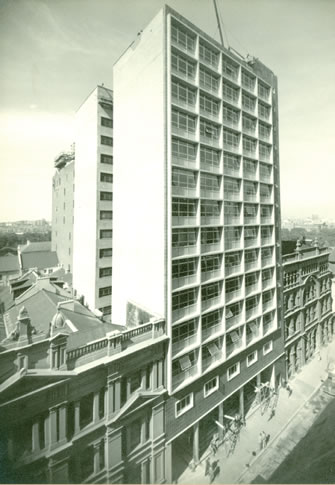
|
In a circular to all members of the
Bar, Barwick said:
"The erection of this building affords the
major hope of preventing the dispersal and disintegration of the Bar. If the Bar has no enthusiasm for it it is no purpose or function of ours to press it on an apathetic group.
We have done no more than offer our good offices to promote and foster the scheme."
By 1 April 1954 he stated that, unless the response from the Bar improved by the end of the following week, a halt would have to be called. Only 135 shares had then been applied for – a tantalising number as the project was obviously doomed unless another fifteen shares could be taken. This was, perhaps, the only occasion in two years when the optimism and enthusiasm of Barwick and Manning faltered, but the former, rather than give up, invited six senior members of the Bar to his chambers one afternoon to have a talk about an “important matter'. They left having agreed to underwrite a further sixteen shares; meaning that applications for 151 shares had been received and success was ensured. Barwick and Manning headed the list of underwriters taking three further shares each. By May 1954 seventeen additional members of the Bar had applied for fifteen shares and, shortly afterwards, all underwriters were released from their obligations. Because the shortage of building materials had eased and because of the Directors' foresight in acquiring sufficient steel at £62 a ton, which, if bought after tenders had been finalized, would have cost £80 per ton, it was decided to call for tenders for a fixed price instead of having the building erected on a 'cost plus' basis. At a Directors' meeting on 30 July 1954 the Chairman reported that tenders had been called for and would close on the month following. A tender of John Grant and Sons Pty. Limited was accepted. In July 1954 the Directors decided to appoint a Secretary-Manager who could also, if the Bar Association were agreeable, carry out some administrative duties for it and for the Bar Council. The Council viewed this favourably and agreed to contribute to the salary of the proposed officer. Applications were then invited from members of the Bar for appointment to a position styled Registrar of the Bar Council and Manager and Secretary of Counsel's Chambers Limited. In December 1954 L. F. Osborne, a barrister, was appointed to this joint position and commenced duties as from 1 January 1955. At this time there were forty-two members of the Bar on the waiting list for shares. The Directors accordingly decided to make available another floor in the building for the use of the Bar. Completion of the construction work was another matter. Towards the end of 1955 a director of the building company indicated that it was unable to meet its liabilities or to carry out the contract unless this was varied to a ‘costs plus' basis. This the Board of Counsel's Chambers Limited declined to do. Shortly afterwards a secured creditor appointed a receiver of the building company whereupon Counsel's Chambers Limited in due course determined the contract. |

1957. The new Wentworth Chambers Building
towers over the old Selborne Chambers (left).
The architects were requested to negotiate another contract to complete the work urgently and in January 1956 the Directors accepted a tender of Sir Lindsay Parkinson (Australasia) Pty. Limited to complete the building on a fixed price basis by the end of the following November. Even that proved too ambitious as prevailing wet weather and industrial disputes convinced the architects by May 1956 that the building would probably not be ready for occupation until March or April 1957 and this was substantially correct. It had then to be decided what to call the new structure. Some members of the Bar thought that the Board's suggestion of ‘Westminster Hall' was unsuitable, but there was favourable interest in the name ‘Westminster Inn'. The Directors, however, on a vote selected "Selborne Hall", though many shareholders expressed dissatisfaction. To dispose of the conflict a special general meeting of shareholders was held in December 1956 when it was resolved that a ballot should be held of the names Barton, Counsel's Chambers, Edmund Barton, Lachlan, Macquarie, Westminster and Wentworth. The name ‘Wentworth Chambers' received the most support and was adopted. It commemorates William Charles Wentworth, one of the first barristers to be admitted in the Supreme Court of 1824. He was a remarkable figure as politician, lawyer, newspaper proprietor, explorer and student who well deserved the grandiose contemporary description of ‘The Australian Patriot'. |
|
Aerial view of crowd gathered for the opening ceremony of Wentworth Chambers.
| |
| Previous Page | Next Page | |